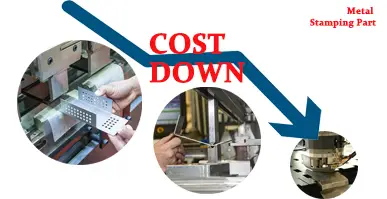1. What is Metal Stamping
Stamping is a process of applying external force to sheets, strips, pipes and profiles through punches and dies to cause plastic deformation or separation to obtain workpieces of desired shape and size.
Generally, there are cold and hot stamping, and usually metal stamping refers to cold stamping as it is widely used. Stamping process includes separation and forming.
● Separation process:to separate the metal sheet according to a certain outline to obtain a stamping part of a specific shape, size and cut surface. This process includes: blanking, punching, cutting, trimming, etc.
● Forming process: The metal sheet is plastically deformed without breaking to obtain a stamping part of a desired shape and size. This process includes: drawing, flanging, shaping, drilling, bending, etc.
2. What Kind of Products are Suitable for Stamping
In general, stamping part is thin-sheet (usually sheet thickness≤6mm) which can be processed by stamping, bending, stretching etc to form a part with same thickness.
3. How to Reduce Metal Stamping Part Costs
1) Materials
Materials can have a direct impact on the pricing. Depending on current material prices and component requirements (like applications’ temperature, environmental, strength, and chemical corrosion requirements etc.), making a material change may allow you to realize some quick savings while maintaining the structural requirements of the component.
2) Tolerance
The tighter the tolerance, the higher the cost (all things being equal). So Review your design to determine the feasibility of increasing the tolerance requirements without impacting the functionality of your design. The cost can be saved if you loosen the tolerances.
3) Stamping Process Design
Cost-saving parts mean simple manufacturing processes, less scrap metal, and innovative die design. The metal stamping part prices aren’t just the metal stamping costs, if your products needing surface finishes after post-production, this would increase costs. So less process can reduce manufacturing cost.
Scrap metal adds material costs, therefore an innovative die design is also a good way to maximize the sheet metal and optimize the stamping process.
4) Order Quantity
Stamping usually requires dies to form the desired parts, which means it won’t be cost effective for small volume (for example, <50,000pcs/year) if die costs are taken into consideration. That is to say, large quantity of over 50,000pcs/year makes more sense with tooling production.
5) Lead Time
Sometimes, the lead time can impact the productivity and cost, causing quality issue or expedite fee. Therefore, examine the average lead times for the past year and determine how reductions would affect your productivity and bottom line.
For over 20 years, Xiame Eternal Precision has been a custom stamping manufacturer with extensive experience and professional expertise. With ISO 9001 certification, we are here to assist you throughout the whole steps of metal stamping process, provide quality products, and exceed your expectations within a reasonable budget. Contact us right now to request a quick quote.



